The sigma network is hosting a free workshop hosted by the Mathematics Resource Centre, University of Bath on Thursday 31st August, 10:30-16:30.
This event will provide:
- a hands-on introduction to Numbas, including logging on to the mathcentre editor, selecting questions to make tests, and writing your own questions.
- a resource swap shop. Opportunity for all delegates to share information on a resource they use.
- information about using Numbas to fill the gaps in mathcentre.
There’s more information on the event’s page on the sigma website.
In this series of posts, we’re highlighting questions we’ve found on the public Numbas editor which do something innovative or are of particularly high quality.
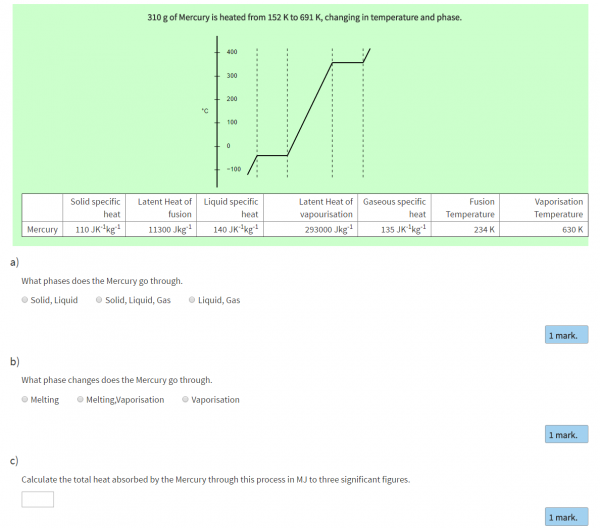
This question by Dr. Tom Stallard of the University of Leicester asks students to interpret a graph showing the temperature of a material as it is heated. The graph is dynamically generated using the JSXGraph extension, and a table shows some of the physical properties of the material.
While quite a simple question pedagogically, I like how the dynamic graph in this question displays information to the student in an intuitive format.
We asked Tom how he uses Numbas in his teaching:
I am an Associate Professor of Planetary Astronomy at Leicester. I use Numbas for the College of Science and Engineering Foundation Year, teaching the module Heat and Energy. I use Numbas both as a teaching aid, providing randomised questions at the end of each lecture that the students can use to practice with as the course continues, as well as a form of continuous assessment, with a set of randomised questions every two weeks that the students can re-take to a passing grade. Because the students use these questions extensively, I make sure to include a broader range of randomisation, so that not only the specific numbers, but the aims and content of the questions can change each time the question is asked.
Thanks to Tom for releasing this question under a CC-BY licence, so others can reuse this question freely!
Try this question now, on the Numbas editor, or have a look at the rest of Tom’s freely-available content.
In this series of posts, we’re highlighting questions we’ve found on the public Numbas editor which do something innovative or are of particularly high quality.
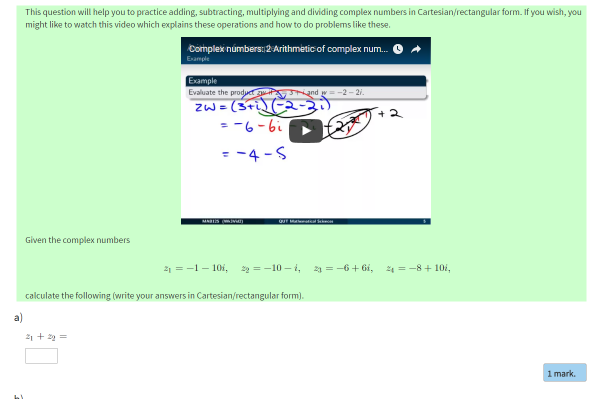
In this question, Dann Mallet of QUT very effectively integrates a video from his course to remind students of the rules of complex arithmetic before testing them on some basic operations.
It’s really easy to include a video in a Numbas question – Dann has uploaded his recording to YouTube, then embedded it in his question statement using the “embed video” button in the editor (there’s a screencast in the online Numbas docs showing exactly how).
We asked Dann how he uses Numbas in his teaching:
I’m the Director of Learning and Teaching for Mathematical Sciences at Queensland University of Technology (Brisbane Australia), as well as teaching students of mathematics, engineering, science and education degrees. Part of my directorial responsibilities is knowing about, testing and encouraging others to use innovative technologies for teaching mathematics. This is how I got onto using Numbas – I’m working to push us from a reliance on WeBWorK to Numbas, which I find to be more friendly to “creative” teachers. So far, I’ve only managed to play around with numbers to give my students some outside of class time activities to work on.
And thanks to Dann for releasing this question under a CC-BY-NC-SA licence, so others can reuse this question freely!
Try this question out now, on the Numbas editor, or have a look at the rest of Dann’s freely-available content.
In this series of posts, we’re highlighting questions we’ve found on the public Numbas editor which do something innovative or are of particularly high quality.
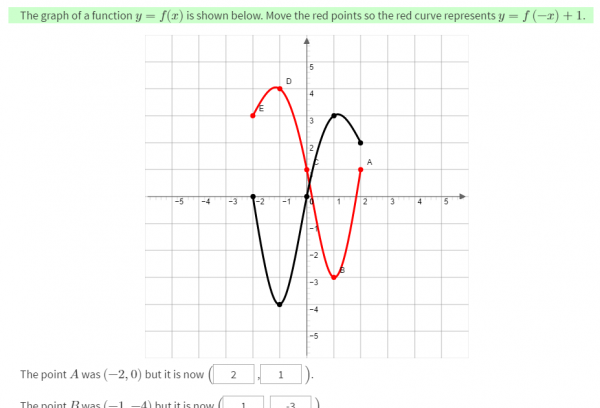
In this question, Ben Brawn of the University of Newcastle, Australia (our namesake down under!) tests your understanding of plane transformations by asking you to move points on a function’s curve corresponding to a given transformation.
I like how this question encourages students to explore their understanding of plane transformations graphically, by dragging points about. They can also work the other way, writing coordinates in the boxes and seeing how that affects the graph. There’s extra information under the “Show steps” button, making great use of the conditional visibility feature to show hints relevant to the particular transformation shown.
We asked Ben how he uses Numbas in his teaching:
I work at the University of Newcastle, Australia in the Centre for Teaching and Learning as a Mathematics Learning Adviser. The select few of us with this title, work with students individually (through a booking system and regular drop in sessions) and in groups (through regular workshops) to help them make sense of mathematical content. We advise students on how to study for courses that involve mathematics, help them see the big picture in their courses and create mathematical learning resources that we feel are useful for students. We also try to work with lecturers to improve courses if we identify issues.
I create practice examples on basic maths topics (eg primary/high school) and share them on a Blackboard site that all the students at our university have access to. This way regardless of what degree they are studying they have access to basic maths practice and help. If they can’t follow the explanations given in the Numbas practice exams then they contact us for further help, either through email, video chat, or in person.
I have also created course specific questions and exams at the request of lecturers that are placed on their own blackboard course sites and these have only ever been used for practice without marks attached. But who knows, maybe one day we will use Numbas for assessment with marks attached.
Ben has produced a huge amount of high-quality questions on basic maths topics, with over 150 released under a CC-BY-NC-SA licence, free for anyone to re-use. Thanks, Ben!
Try this question out now on the Numbas editor, or have a look at Ben’s other freely-available content.

The MathJax team has announced that their free cdn.mathjax.org service, which serves copies of MathJax, will shut down on April 30, 2017 – the end of this month. Numbas uses MathJax to render mathematical notation using LaTeX, and until now the default theme has used cdn.mathjax.org.
This is much less notice than we would’ve liked, but it’s out of our hands. So we need to change how Numbas uses MathJax from now on, and the shutdown has ramifications for existing exam packages.
How Numbas will use MathJax from now on
In short: there’s a new default URL, and you shouldn’t notice any difference. You can configure Numbas to use your own copy of MathJax if you’d prefer.
Read the rest
We’ve made a few changes to Numbas and the editor recently, with the aim of improving usability. It involved moving some parts of the editor around, so I thought I’d better show what we’ve done.
First of all, when you submit an answer to a part of a Numbas question, the input changes colour depending on the score you were awarded. (If you’ve got score feedback turned off, it turns the same colour no matter how you did)
Here’s an example:
Read the rest
Numbas has acquired a few new features and had a bit of a tidy-up in the last couple of months, so I thought it was time to bump the version number up to 2.1 and let you all know what’s been happening with another development log.
Groups of questions in exams
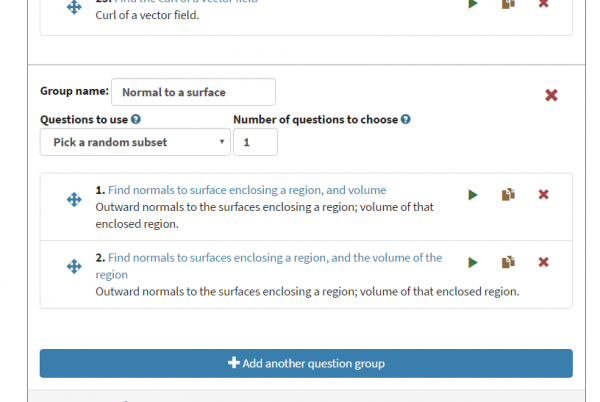
You can now separate the questions in an exam into groups, allowing you to pick a subset from each group at random. This feature was requested by Ione Loots at the University of Pretoria, who wanted a way of showing students a randomly-picked variation of each question in a test. (documentation, issue) Read the rest
We’re happy to announce the release of a Basic LTI 1.1 tool provider for Numbas exams.
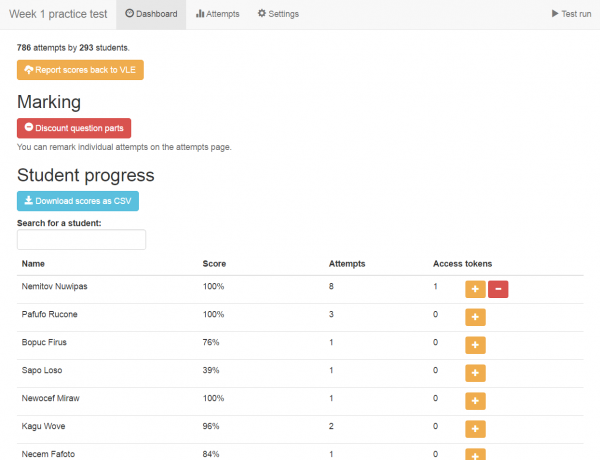
One of the more complicated parts of using Numbas is getting it to work with your Virtual Learning Environment (VLE). We designed Numbas to use the SCORM standard, which ideally would allow it to run in any SCORM-compliant VLE without any configuration or input from the server administrator. However, there have always been a couple of wrinkles in that plan: not all VLEs support SCORM, and some of those that claim to don’t do it properly.
Blackboard’s SCORM player has a few long-standing bugs and missing features which mean that we haven’t recommended it for serious use. Since we can’t fix those problems ourselves, we’ve spent a long time trying to find a way work around Blackboard’s problems. Additionally, when a large contingent of Norwegian lecturers visited us for the MatRIC colloquium this April, we discovered that very few institutions in Norway use VLEs which support SCORM. Someone suggested we look at LTI, since many more VLEs seem to support it. Read the rest
The vast majority of development work on the Numbas system has been carried out by the e-learning unit of Newcastle University’s School of Mathematics and Statistics. In particular, almost all the code was written by me.
I’ve set aside time to write up information on how you can get involved with the Numbas project. I’ve greatly expanded our “Contributing to Numbas” page, listing the different ways you can help. I’ll reproduce the top part of that page here:
We encourage any kind of contribution to the Numbas project, whether it’s a bug fix, a new feature or extension, documentation, or just a suggestion of a feature you’d like to have.
We are always interested in feedback from users, especially those with interesting ideas on how to develop and improve the system.
Here’s how you can contribute to the Numbas project
- Report bugs, or suggest features you’d like to see, on our issue trackers.
- Blog about how you use Numbas.
- Write some documentation.
- Add a feature or fix a bug by contributing code.
- Translate Numbas into your language.
Read the rest
You can now embed GeoGebra applets in Numbas questions and, using GeoGebra’s new exercises feature, award the student marks based on constructions within the applet. This is a huge step forward, making it much easier to include interactive diagrams in Numbas questions.
Here’s a video showing how to embed a GeoGebra applet in a Numbas question, and award the student marks if they complete a certain construction. There are even steps, giving marks for each stage of the process!
You can use the values of Numbas question variables in the definitions of objects in the GeoGebra worksheet, meaning that diagrams can accurately reflect the rest of your question.
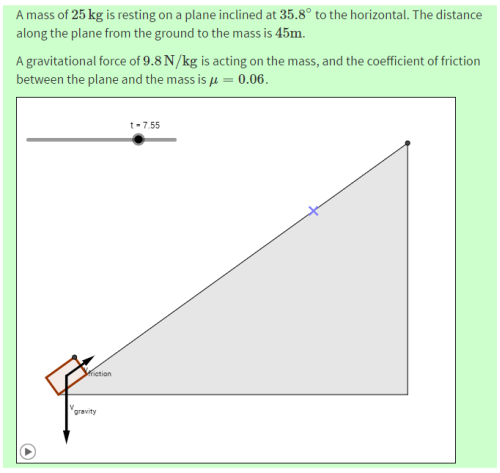
In this question, the gradient of the slope and coefficient of friction are randomly generated in Numbas, then passed to the GeoGebra applet.
I’ve put together a small demo exam with a couple of questions showing some ways you can use GeoGebra inside Numbas.
To get started using GeoGebra in your own Numbas questions, read the extension’s documentation.






